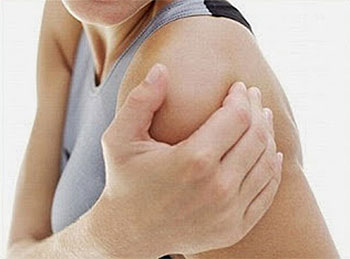Specialities
Diagnosis and Treatment for Frozen Shoulder (Stiffness) in Chennai

Stiffness around the shoulder joint, debilitating pain and limited range of movement in the shoulder are all symptoms of “Frozen Shoulder” or “Adhesive Capsulitis”. The onset of this disorder is very slow and to regain the use of the shoulder, free of pain is also a slow process.
Composition of the Shoulder
The shoulder comprises a ball and socket joint. Three bones conjoin to form this joint
- The shoulder blade or scapula
- The collarbone or clavicle
- The upper arm or humerus
The head of the humerus fits into the shallow socket of the shoulder joint, and the connective tissue also known as the shoulder capsule, envelops the joint. Synovial fluid present in the shoulder capsule, lubricates the shoulder capsule and the joint and thereby enables the shoulder to move more easily.
When the connective tissue in the shoulder capsule becomes rigid due to the formation of tight bands of tissue or adhesions, with a simultaneous decrease in the level of synovial fluid, it causes stiffness and limits the range of motion, of the shoulder. This condition is referred to as “Frozen Shoulder”.
Stages of Adhesive Capsulitis
Factors
Diagnosis
The doctor will either conduct a physical examination or will request for an x-ray or MRI to rule out other causes or injuries. The Orthopedic Surgeon may also request an Ultrasound if suspecting a thickening of the broad ligament (coracohumeral ligament), which helps strengthen the capsule in the shoulder joint. Thickening of the coracohumeral ligament or CHL is another suggestive factor of adhesive capsulitis or frozen shoulder.
Treatments
The minimum time taken for a frozen shoulder to regain its normal range of motion or near normalcy, could be 3 years, if left untreated.
The aim of treating a frozen shoulder is to curb the pain and to improve the range of motion in the shoulder and to strengthen the shoulder.
Non-Surgical Treatments
Include:
Surgical Treatment
When a patient diagnosed with frozen shoulder disorder, fails to respond to any of the non-surgical treatments, listed above, then surgery will be considered.
The aim of performing surgery is to remove the stiffness from the joint and to stretch the connective tissue. This is done either by manipulation under anesthesia (MUA) or through shoulder arthroscopy.
MUA – This procedure is performed by the Orthopedic Surgeon. Anesthesia is administered and while the patient is under, the Orthopedic Surgeon will manipulate the shoulder joint to move, causing the capsule and scar tissue to either tear or stretch, consequently releasing the stiffness and increasing the range of motion.
Surgical Capsular Release or Shoulder Arthroscopy – After anesthesia has been administered, the Orthopedic Surgeon will make 2 or 3 tiny, keyhole incisions into the afflicted shoulder. An arthroscope (camera measuring 3 and half millimeter) is inserted into one of the incisions. The images from the camera are projected onto a computer screen. Through the other two incisions, microsurgical instruments are inserted to surgically release the frozen shoulder.
Sometimes, the orthopedic surgeon may use both the manipulation and arthroscopy procedures simultaneously, to get the maximum outcomes.
In a Nutshell
What is a Frozen shoulder?
The shoulder joint is a complex ball-and-socket joint made up of several bones, ligaments, tendons, muscles and fluid-filled sacs called bursae. The joint can get injured or be affected by a wide range of conditions such as fracture, dislocation, impingement, rotator cuff tear, tendonitis, bursitis, gout, rheumatoid arthritis, osteoarthritis, and frozen shoulder. In frozen shoulder, an inflammation develops in the joint leading to pain, stiffness and restricted movement. The medical term for the condition is Adhesive Capsulitis, which can be primary or secondary.
What are the signs and symptoms?
Adhesive Capsulitis goes through three stages called – Freezing, Frozen and Thawing stage, with each phase lasting a few months. In Freezing and Frozen stages, there is moderate to severe pain, with increasing level of stiffness or restricted movement of the shoulder. In the Thawing stage, the pain reduces and the range of movement improves.
How is this diagnosed?
Physical tests are the most common method of confirming the condition. The doctor will inject the joint with an anesthetic to numb the pain and then observe your range of active and passive movements. Further, he/she may order imaging tests like X-ray, CT or MRI scans to rule out other conditions that may also be present.
How is Frozen shoulder treated?
More than one treatment option will be prescribed and these include over-the-counter painkillers, physical therapy, steroid injections, joint distension, shoulder manipulation and surgery. Surgery, however is rarely used. All these are administered by qualified and experienced orthopedic doctors or surgeons, which ensures good outcomes, quick recovery and rehabilitation.
